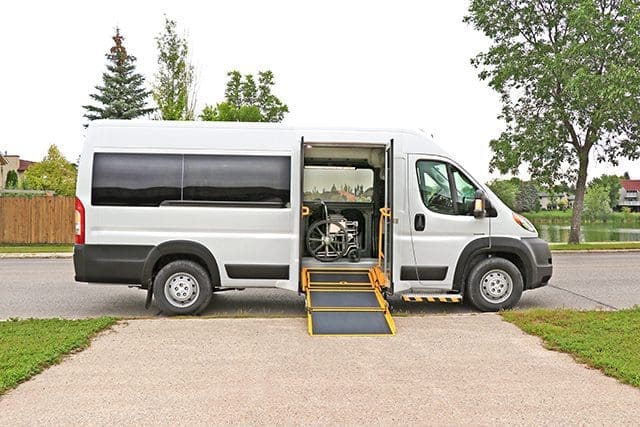If you’re a municipality, First Nation community, or non-profit, you might be struggling to keep your transit services going. And you’re not alone. Many organizations across Ontario and all of Canada are facing funding problems. Without proper financial support, transit services that people rely on could be in trouble. That’s where the Ontario Transit Investment Fund (OTIF) may be of help.
Not knowing about this fund could leave your community without affordable, reliable transportation. But understanding it could be the answer you need.
At MoveMobility, we’ve spent over 20 years helping organizations like yours and the Blood Tribe Department of Health reduce healthcare and transportation barriers with customized vehicles. We know how important transit is for connecting people to healthcare, work, and each other. We’re here to give you the facts, not just sell our services. We believe in sharing helpful information because when transit works, communities thrive.
In this article, we’ll explain what the Ontario Transit Investment Fund is and how it can potentially help solve your transit funding problems.
What is the current state of transit services across Canada?
Transit systems across Canada are struggling to stay on track. Many cities just don’t have the funds to keep their transit programs running smoothly, and the problem is getting worse. Without more money, transit services could start to spiral downhill, making it harder for people to get to work, school, the hospital, or important appointments.
Here are some examples of cities feeling the pressure:
- Calgary: Faced a $33 million budget gap in 2023
- Toronto: Had a massive shortfall of almost $370 million
- Halifax, Montreal, Ottawa, Winnipeg, Edmonton, and Vancouver are also dealing with budget shortfalls
These shortfalls mean that cities might have to cut services, raise fares, or delay important improvements. This doesn’t just affect large cities—smaller municipalities and communities are also feeling the strain. Public transit is key for so many people, especially those who rely on it as their only source of transportation.
Imagine not being able to make it to an important medical appointment, like weekly dialysis treatments, because local transit services are too expensive.
Many of these cities are heading toward bigger problems without new funding, especially in Ontario. But that’s where programs like the Ontario Transit Investment Fund can make a difference.
Keep reading to learn what the Ontario Transit Investment Fund is and how it will work.
Ontario Transit Investment Fund: What is it and how can it help?
For many small towns and rural areas across Ontario, getting from one place to another isn’t always simple. Public transportation options are often limited, making it hard for people to get to work, see family, or reach important services. That’s where the Ontario Transit Investment Fund (OTIF) can make a difference.
The Ontario Transit Investment Fund is a new initiative the Ontario government is working on. The idea behind it is simple: to provide $5 million a year, starting in 2025, to help communities that don’t have enough public transportation.
What will OTIF do for communities?
OTIF is focused on making life easier by bringing reliable transit options to places that need them most. The fund will support projects designed for the unique needs of smaller communities, with practical transit solutions like:
- New bus routes that connect rural areas to nearby towns and services
- On-demand shared rides where passengers can book a ride when they need it
- Door-to-door services for people who might not be able to reach a regular bus stop
These options mean more freedom for people to access the things they need every day, whether it’s a doctor’s visit, a job interview, or a family gathering. In areas like northwestern Ontario, where towns can be far apart and transportation is limited, OTIF can open up new possibilities.
Kevin Holland, MPP for Thunder Bay – Atikokan, notes that OTIF will help people stay connected to family, services, and larger urban centers—especially important in regions where transit access has always been a struggle.
To find out what projects are eligible or ineligible and how much the OTIF will cover, download the guide below.
Your guide to the Ontario Transit Investment Fund: Next steps

You came to this article because you’re looking for ways to improve transit services in your community. In this article, you’ve learned about the current issues with transit services funding and how the OTIF could offer much-needed relief. We’ve also covered how you can contribute your feedback to help shape this fund to meet your community’s specific needs.
At MoveMobility, we’re passionate about making a difference in communities like yours. We do that by manufacturing mobile medical and wheelchair accessible vehicles so organizations can help people. If you have any questions or need guidance on anything discussed in this article, click the button below to talk to a mobility expert.
If you’re not ready to connect just yet, we have more resources available to help you learn more.
Because we’re already talking about funding, we think you’ll find our article on how to get more funding for your wheelchair van helpful.
Along these same lines, our article on how to apply for funding in six steps will also help you in the right direction.
Note: MoveMobility does not provide this funding and cannot assist with applications. This information is shared to help raise awareness and encourage support for funding or grant opportunities that may assist your program.






